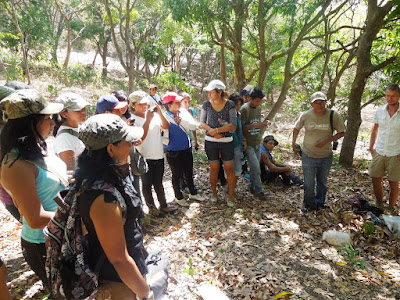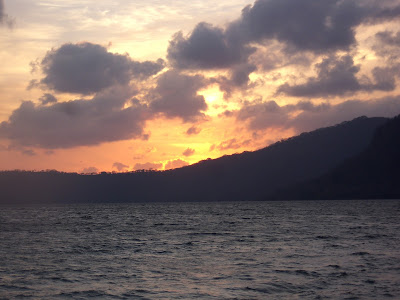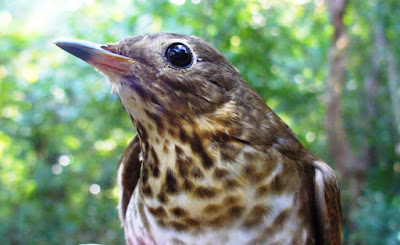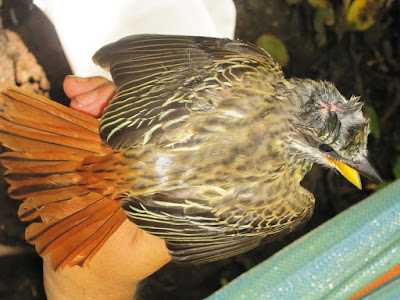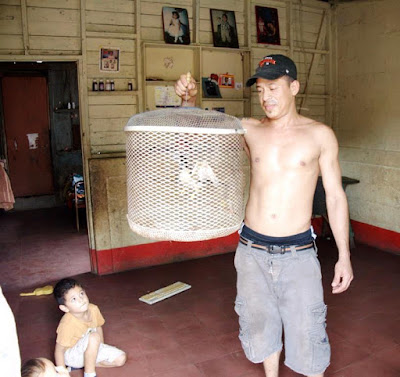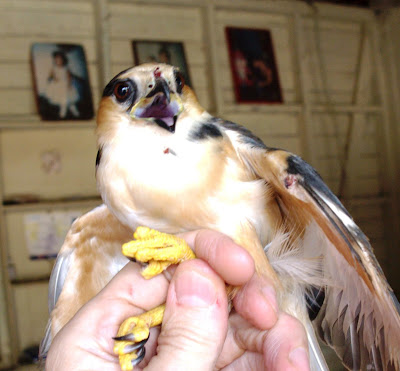 |
| This monkey certainly was assertive! Photo Pablo Somarriba. |
After a few bites, the owners who once thought having a monkey on a chain would make them popular among their friends, and perhaps bring them happiness to fill that void that is formed when one is in an endless cycle of abuse, decided that a monkey was no longer as interesting as before. She was brought to us by volunteers from Fundacion ADAN, in Managua, and we monitored the monkey several days before releasing her into the wild, in an area where she would quickly encounter others of her species.
White-faced capuchin monkeys are clever and cute. This monkey wanted and attracted attention very well. She made friends fast. Her mischief was generally benign, and she kept people laughing.
 |
| The monkey made a special bond with Elmer, who has a special way with animals. Photo Pablo Somarriba. |
But recently, her happy day came. With volunteers and GAIA staff in tow, she made the trek from Estacion Biologica to an area in Laguna de Apoyo Nature Reserve where others of her species (Cebus capucinus) are found.
 |
| This White-faced capuchin monkey was very active, while at Estacion Biologica! Today, she lives wild and free, in the forests of Laguna de Apoyo Nature Reserve. Photo Pablo Somarriba. |
Once on their way to the spot she will find as her new, wild home, the monkey continued to play. She had already developed a bond with Elmer, and she went without making any problems. She had no idea of the big adventure ahead of her.
Once they were in an area with White-faced capuchin monkeys, they entered on a path into the forest. It was important to leave the monkey as close as possible to others with whom she will bond and associate.
Once she was released from her cruel collar, she slowly tested her new limits. First, she only sat and observed her human friends, glancing at the abundant forest without moving. Then, she was taken by bravery. She tested a small tree, and found it to her liking. Her memories of the wild had not left her. Within seconds, she jumped from one small tree to another, then scaled to several meters height. Within a few minutes, she was gone, not to return. What an emotional start to a new, free life!
Wistful but satisfied that one more sentient being in this universe will live and die according to her biological mandates, and not in captivity, the crew of volunteers and GAIA staff went back to Estacion Biologica to contemplate it all. After all, White-faced capuchin monkeys have many human qualities. It seems so natural that someone would see a monkey act cute and adorable and think, "I want one". Yet, when we see how this monkey acted, once free, the answer was clear. She tolerated us but she knew where she belonged. She scaled the trees and never returned. We hope someday to see her again, but from afar, and hopefully, in the company of her new simian friends. She, and all wild animals, deserve to live and die in their natural habitat, not in a cage or on a chain.
This monkey is now in the forest, where she wants to be, but there are still many things to do in Nicaragua, to combat the illegal traffic in animals. Would you like to help us protect the wild nature of Nicaragua? You can work with us in many ways. One is to adopt a rescue animal. We have animals that need food and care, and their costs average fifteen dollars per month each. You can help us expand our capacity to care for wild animal rescues by helping to finance new enclosures and transportation costs. And, most importantly, you can help by volunteering with us.
It makes us emotional to think that we can bring happiness into the life of a small animal that looks so much like us, so easily. It seems like so little, but at the same time, so much to bring a monkey back to her life that she abandoned unwillingly, by the cruel acts of other humans. When we saw her go away and not look back, we knew we had done something good.
 |
| Click on the "escudo" to contact us at Gaia Nicaragua. |






